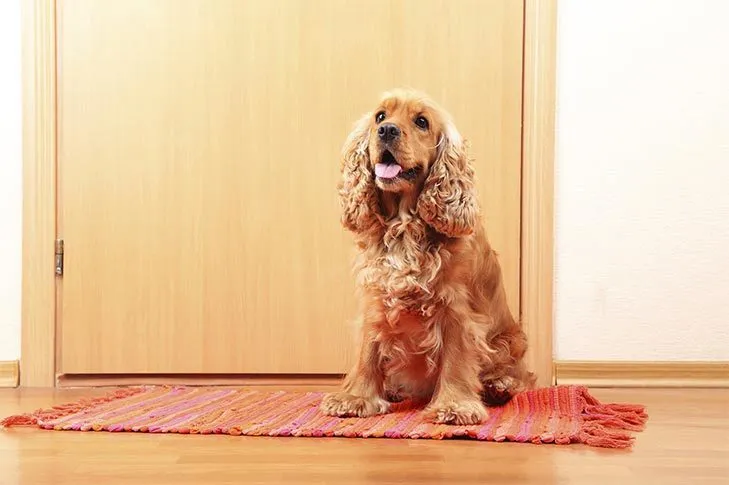Teaching your dog to ring a bell to pee is a highly effective way to improve communication and reduce potty accidents in your home. This simple yet profound training method empowers your dog to clearly signal their need to go outside, fostering a stronger bond between you and your furry companion. By understanding your dog’s cues and providing them with a clear means of expression, you can alleviate frustration for both parties and establish a harmonious routine for potty breaks.
Choosing the Right Potty Communication Tool
When you decide to Train Dog To Ring Bell To Pee, you have a couple of excellent options for communication tools. The most straightforward and budget-friendly choice involves using bells, typically hung from a doorknob or placed near the exit door. Some bell systems even include receivers around your home, ensuring you hear the signal no matter where you are. For a more advanced approach, “talking buttons” offer a high-tech solution. These recordable buttons, popularized by speech-language pathologist Christina Hunger and her “Hunger4Words” phenomenon, allow you to teach your dog to “talk” by associating specific words with buttons. While both methods are effective, bells often provide a quicker entry point for teaching basic potty requests. Regardless of your choice, the goal is to establish a clear, consistent signal for your dog to use. Exploring things you can train your dog to do often highlights the versatility of canine learning, and bell training is a prime example of a practical skill that benefits daily life.
 A focused English Cocker Spaniel patiently waiting by a doorway, ready to communicate its need to go outside for potty breaks.
A focused English Cocker Spaniel patiently waiting by a doorway, ready to communicate its need to go outside for potty breaks.
Step-by-Step Guide to Bell Training Your Dog
Successfully teaching your dog to use a potty bell relies on consistency and positive reinforcement. Unlike simply luring them to touch a target, this method focuses on helping your dog understand the purpose behind ringing the bell – to communicate their need to go outside.
Step 1: Introduce the Bell and Build Positive Association
Begin by introducing your chosen bell or button to your dog. Allow them to inspect, sniff, and explore it without pressure. This initial interaction is crucial to ensure the item doesn’t cause any anxiety. Reward any interest or engagement with treats and praise, helping your dog form a positive association with the bell from the outset.
Step 2: Establish the Bell-Exit Connection
Place the bell or button prominently near the door you most frequently use for potty breaks. Every single time you take your dog outside, make it a habit to press the button or ring the bell yourself. The key here is repetition. Through consistent demonstration, your dog will gradually begin to associate the sound of the bell with the act of going outside. This crucial step builds the foundation for their understanding. Remember that consistency is paramount in all aspects of training, from basic obedience to more complex requests like fun tricks to do with your dog.
Step 3: Encourage Independent Bell Ringing
Dogs are keen observers and learn a great deal by watching our actions. After consistent observation of you ringing the bell before exits, your dog will start to grasp the connection. Continue this routine until your dog begins to independently ring the bell without any prompt from you. When this happens, it’s a breakthrough moment! Respond immediately with enthusiastic praise and take them outside. This immediate positive reinforcement solidifies the behavior, reinforcing that ringing the bell leads directly to their desired outcome: a potty break.
 A French Bulldog lying calmly beside its leash at the door, demonstrating the patience developed through successful dog bell training.
A French Bulldog lying calmly beside its leash at the door, demonstrating the patience developed through successful dog bell training.
Benefits of Potty Bell Training
Most dogs quickly grasp the concept of ringing a bell or pushing a button to signal their need to go outside. This shared language between you and your dog can significantly reduce household frustration stemming from accidents and improve overall communication. Beyond preventing messes, bell training can strengthen your bond, as your dog feels understood and empowered.
Another significant advantage is the ability for your dog to communicate their needs with other household members, or even a pet sitter, who might not be as attuned to their natural potty signals. This can be especially helpful if you how to stop your dog from jumping up on people or other unwanted behaviors, as clear communication can alleviate general anxiety. The bell system provides a reliable communication channel, ensuring your dog’s essential needs are met, even when you’re away.
Conclusion
Training your dog to ring a bell to pee is a rewarding endeavor that fosters better communication and understanding. By consistently introducing the bell, associating it with outdoor potty breaks, and encouraging independent ringing, you can equip your dog with a valuable tool for expressing their needs. This simple training not only reduces accidents but also strengthens the bond you share, making daily life more enjoyable and less stressful for everyone involved. Embrace consistency, patience, and positive reinforcement, and you’ll soon have a dog who confidently signals their need to go outside.
References
- AKC. (n.d.). The Power of Touch: Teach Your Dog to Nose Target. Retrieved from https://www.akc.org/expert-advice/training/the-power-of-touch-teach-your-dog-to-nose-target/
- AKC. (n.d.). How to Prep House for Pet Sitter. Retrieved from https://www.akc.org/expert-advice/home-living/how-to-prep-house-for-pet-sitter/
- Hunger, C. (2020). How Stella Learned To Talk: The Groundbreaking Story of the World’s First Talking Dog. Retrieved from https://www.amazon.com/How-Stella-Learned-Talk-Groundbreaking/dp/0063046849
